
| Shōmu | |
|---|---|
| Emperor of Japan |
Shōmu, in full Shōmu Tennō, personal name Obito (born 701, Yamato [near Nara], Japan—died June 21, 756, Nara), 45th emperor of Japan, who devoted huge sums of money to the creation of magnificent Buddhist temples and artifacts throughout the realm; during his reign Buddhism virtually became the official state religion.
He ascended the throne in 724, taking the reign name Shōmu. In 729 his consort, a member of the powerful Fujiwara family, was declared empress, shattering the precedent that all empress consorts had to be princesses of the blood. Shōmu and his wife were both devout Buddhists, and he attempted to create a Buddhist structure throughout the country that would parallel the existing nationwide state bureaucracy. To this end he lavished huge sums of money on existing temples and monasteries and in 741 ordered the founding of a branch monastery and nunnery in each province. In addition, every temple was given a scripture (sutra), which the emperor himself copied out. The Tōdai Temple in the capital city of Nara was erected as the central temple. Rebuilt on a smaller scale nine centuries later, its Great Buddha Hall (Daibutsuden) is still the largest wooden building in the world. The original hall was 288 feet (88 metres) long, 169 feet (51.5 metres) wide, and 156 feet (48.5 metres) high and housed a huge bronze image of Vairocana (Birushana Butsu), the universal Buddha, which Shōmu had made as a protector of the central government. Begun in 743, the approximately 53-foot- (16-metre- ) high seated figure utilized 500 tons of copper, tin, lead, and gold gilding. Marred by later repairs, the statue is not considered a great work of art, but it is one of the two largest bronze figures in the world. Shōmu dedicated it in his celebrated speech of 752 in which he declared himself the slave of the Three Precious Things—the Buddha, Buddhist law, and the church. The ritual objects used in this dedication ceremony, together with the emperor’s personal effects, were placed in the large log-built imperial storehouse called the Shōsō Repository (Shōsō-in). These well-preserved artifacts provide a unique account of 8th-century Japan. Although Shōmu’s building program depleted the imperial treasury, the Nara period is considered one of the richest cultural periods in Japanese history.
Gyōki, Bodhisattva of Japan (668-749)
For more than a thousand years, the Japanese Buddhist priest Gyōki has been well known for his seventh-century charitable religious activities. His biographies and hagiographies tell that not long after the “official introduction” of Buddhism into Japan, Gyōki roamed the countryside propagating the teachings together with farming techniques to oppressed people hungry for both. His activities correspond to a Bodhisattva ethics that stand in defiance of both secular law and monastic codes at a time when the government was struggling to establish and maintain strict control of Buddhists by confining them to temple grounds for academic study. With supporters outside the capital swelling to thousands, an imperial edit was issued against his actions. This tactic seems to have backfired as Gyōki's hero status continued to grow among the non-aristocratic population. Perhaps as a result, the government eventually reversed its stance toward Gyōki and he was awarded the rank of High Priest (Daisōjō). Meanwhile, among the people he became known as the Bodhisattva Gyōki (Gyōki Bosatsu). Subsequently, he became the first person in Japan to be awarded the title Bodhisattva by the government as an official rank.
Throughout Japanese history, Gyōki reappears in literature as an archetype of both a man of the people and as a shaman-priest. The most famous of Haiku poets, Matsuo Bashō, wrote of Gyōki in his seminal work Narrow Road to the Deep North.
The Chinese graph for chestnut consists of west and tree and is, therefore, linked up with the Western Paradise of Amitābha (J. Amida). This is why the Bodhisattva Gyōki all throughout his lifetime used the wood of this tree both for his walking stick and for the pillar supports of his house.
Men of the world
Fail to see its blossoms:
Chestnut of the eaves.
Bashō’s literary conception of Gyōki follows the often-portrayed image of his predecessor. Since at least four hundred years after Gyōki’s death, when he was further immortalized in the Miraculous Tales of Japan, typical features found characterizing his persona as seen in Bashō’s words include, 1) much walking and living among the people as opposed to being confined to temple study as the government of his day would have it, 2) fervent belief in Amida’s Paradise in the West, 3) the blend of shaman-like powers and Buddhism as with his ability to perceive the true nature of things, in contrast with the vision of “men of the world.”
These qualities may explain his popularity and even the worship of him in the Kamakura period, over five hundred years after his death when such an image would be revered. Yet, from biographical and physical evidence dated earlier, researchers now question at least the latter two components of his popular image, if stopping short of the more radical suggestion that his entire biography could have been fabricated. Nevertheless, if Gyōki’s faith in the saving powers of Amida was grossly exaggerated and if his life was not a blend of shamanism and Buddhism, the emerging portrait of him as propagator of an earlier or 'more pure' form of Buddhism is even more appealing to a modern audience. The early national histories of Japan clearly indicate the government’s position on Buddhism at the time Gyōki lived was that it offered to their disposal a magical potential that could be harnessed for economic, political and healing powers. Writings such as the Nihon Shōgi andShoku Nihongi leave little room for doubt that this accounts for the official interest in Buddhism and controlled support of its study and practice. Nevertheless, besides being perceived as an uncontrolled spiritual power, Gyōki may have been imagined to present, his arrest was likely related to reports of huge gatherings of rural people he was organizing. This was seen as an imminent political threat to the instable power of the capital.
Gyōki’s reported behavior centers on building hostels, opening farm lands, constructing irrigation systems and other charitable activities aimed at improving life for a large number of people. This emphasis does not tell of a tendency to rely on magic or the saving power of another (tariki [1] ) as seen after Gyōki’s time in the esoteric Buddhist movements of the Heian period and the Pure Land traditions become immensely popular afterwards. For this and other reasons, researchers have suggested the possibility that the Buddhism Gyōki propagated may instead be seen to represent a tendency toward rejection of the notion of magic Buddhism embraced by the government, as well as their scholastic studies. In addition, Gyōki’s Buddhist master was master Dōkyō, who first propagated the Hossō (Sanskrit: Yogācāra) tradition in Japan. Many aspects of Gyōki’s charitable projects are easily understood in light of the content of Yogācāra texts that Dōkyō is known to have imported from China and taught in Japan. Viewed in this way, Gyōki’s was a mass movement against the government's insistence on magic and scholastic study by Buddhists. Instead, like the historical Buddha Shakyamuni, Gyōki emphasized Buddhist practice, stressing charity work. Saichō, the famous Heian period founder of the Japanese Tendai Buddhist tradition, praises Gyōki for these very qualities and seeks to emulate his lifestyle.
Gyōki’s place in the history of Japanese Buddhism has been insured for centuries by hagiographies and literary works disseminating the image Bashō upholds. If, however, recent scholars are correct in assessing the nature of his form of Buddhism, Gyōki’s role in the history of Japanese Buddhism has not only been mistakenly categorized but also likely underestimated. Regardless, a fabricated image persisting in various usages a thousand years is no less influential. It is the task of the present study to familiarize the reader with portraits of Gyōki's life. Because of the importance of legends about Gyōki for both the history of Japanese Buddhism and to Japan in general, while this study points to modern scholarship and sometimes interprets Gyōki’s actions for a Yogācāra perspective, it also introduces the most influential stories about Gyōki. In order to better explain the activities of his life these are framed within the context of Japanese history and the history of Japanese Buddhism.
Interview with Matthew Welch
Curator of Korean and Japanese Art
1. Can you give us some background on this sculpture?
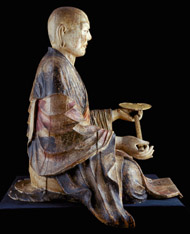
(1) Portrait Sculpture of Priest Gyoki in profile.
This sculpture represents Gyoki, a Japanese Buddhist priest who lived in the 8th century.(1) He traveled throughout Japan, raising funds for the construction of many temples, but also important public works like hospitals, dikes, and irrigation systems that greatly improved the lives of ordinary people. Ultimately, he became the spiritual advisor of Emperor Shomu, and played an important role in the creation of the colossal bronze Buddha of Todaiji. This was a national undertaking and united the country in support of Buddhism. At the time of his death in 749, Gyoki was one of Japan's most celebrated monks and the emperor himself proclaimed him to be a living bodhisattva.
2. So the colossal Buddha was created. Is it still around today?
The bronze Buddha took more than seven years to cast. In 752 the former emperor and empress held a dedication ceremony attended by some 10,000 monks, members of the aristocracy, and military officials. Bodhisena, an Indian monk who made the long journey from his homeland for the momentous event, performed the "eye-opening" ceremony in which he animated the sculpture by painting the irises of the great Buddha with a huge brush.
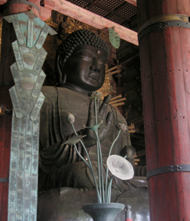
(2) The Great Buddha at Todaiji as it appears today.
The colossal bronze Buddha still exists. The building itself burned twice in the course of Japanese history, and the colossal Buddha was severely damaged on both occasions. So the sculpture that one can see today is very different from the original. Still, it is an awe-inspiring sight that towers over 48 feet above its massive lotus pedestal.(2)
3. OK, so back to our sculpture here. Describe what sets it apart.
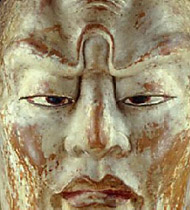
(3) Scowl and knitted brow.
Unlike other depictions of Buddhist deities on display in this gallery, which are unnaturally calm and serene, this image of priest Gyoki is meant to represent an actual person. Consequently, the artist attempted to depict the features that distinguished him as an individual—like the unique way he knitted his brow.(2) Secondly, the artist tried to capture something of the priest's determined spirit. His stern, somewhat fierce stare certainly conveys something of his unwavering resolve to champion Buddhism in Japan.
4. So the challenge would have been about how to convey that unique combination—both human and heavenly.
That's right. Gyoki was considered a living bodhisattva, but he was also a very real person.
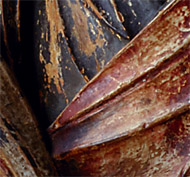
(4) Black and red pigment on the monk's carved robe.
He also wears the robes of a monk. If you look closely, I think you can patches of black and red, even though some pigment has been lost. (4)
The pattern of black and red is meant to represent the priest's kesa(pronunciation: "KAY-sah"), or ceremonial stole. In the past, members of the aristocracy would donate their gorgeous, but worn, robes to Buddhist monasteries. The monks would salvage undamaged pieces of cloth and sew them together in patchwork fashion to create these kesa. In this way, they demonstrated their frugality.
5. It's a little jarring to see such realism in the midst of more stylized figures.
I agree. On the other hand, portrait sculpture and painting is an important part of Buddhist art in Japan. While images of Buddhas and bodhisattvas are the main focus of worship within a temple's main hall, many temples also have smaller halls dedicated to their founders. As a way of reminding young monks about the self-sacrifice and hard work of these great priests, they are often assigned to make offerings and pray before these statues every morning and evening. In this way, a young monk comes to know the priest, who may have lived hundreds of year earlier, in a very intimate way. The realism of the depiction—including facial imperfections, emaciated chest, and so on—helps remind everyone that the priest was, in fact, an ordinary human who achieved great things.
6. Buddhism seems to have been at a real high point in Japan when Gyoki was living.
That's right. By the Nara period—roughly the 7th and 8th centuries—Buddhism had become firmly established in Japan. As in other Asian countries, Buddhism also became a means whereby the ruler could unify the country. Rather than continuing to be a personal path to spiritual salvation—as it originally began—Buddhism, with its vast pantheon of powerful deities, became a means to protect entire nations and their rulers. Consequently, people devoted enormous resources to the construction of monasteries and temples, and in the case of priest Gyoki, to the construction of a colossal Buddha in the fervent belief that it would protect the Japanese from calamities ranging from invasion to devastating typhoons.
7. Tell us about what he's holding.
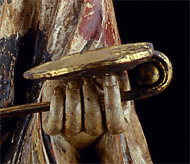
(5) Gyoki holds a scepter, symbolizing authority.
Gyoki is holding a kind of scepter, a symbol of authority, called a nyoi(pronunciation: "NYOY") in Japanese.(5) Buddhist priests typically carrynyoi while conducting formal ceremonies. Nyoi have a large, three-lobed head that is a stylized interpretation of the cloud-eared mushroom. Such mushrooms were believed to have potent medicinal properties and so became an auspicious symbol of long life. While nyoi can be made of a variety of materials, this one is of carved wood covered with black lacquer and gold leaf.
8. Gyoki lived in the 8th century, but this representation of him wasn't made until the 17th century. Why was there so much interest in Gyoki so long after his life?
The enormous building that held the bronze Buddha was destroyed in 1567 during a period of political unrest and civil warfare. Once the Tokugawa regime reestablished order in the country in the early 17th century, they set about supporting the reconstruction of lost or damaged temples. Consequently, people recalled the efforts of priest Gyoki who was responsible for creating the original Buddha in the 8th century. There arose a kind of cult devoted to Gyoki, whose members called upon his spirit to aid them in their efforts to repair the damaged Buddha and rebuild Todaiji temple. As a result, many small memorial halls were constructed throughout central Japan dedicated to Gyoki, and each of these was outfitted with a sculptural or painted image of the priest.
9. Does this help us see where mere humans fit in the Buddhist hierarchy?
In a way. Certainly such devotional images of high priests link the complex Buddhist pantheon to humankind. On the other hand, these men and women are considered paragons of the faith, whose efforts are so superhuman that they are considered living bodhisattvas—a divinity on earth. The most obvious example of this kind of person today is the Dalai Lama, who is also considered to be a living Bodhisattva.
10. Finally, how does this image of Gyoki compare with others?
This image is based on earlier examples. It is likely that images of Gyoki were created soon after he died, but the earliest image that I know about was created in the 1249 on the 500th anniversary of his death. That sculpture is owned by Toshodaiji Temple, in Nara, and it also has the distinctive inverted u-shaped expression on his forehead. So, although the artisans who created the museum's example lived nearly 1000 years after Gyoki's death, they were able to capture the specifics of his appearance by depending on earlier sculptures.
From:
http://www.britannica.com/EBchecked/topic/541505/Shomu
http://en.wikipedia.org/wiki/Emperor_Sh%C5%8Dmu
http://ww2.coastal.edu/rgreen/gyoki.htm
http://www.artsmia.org/viewer/detail.php?v=2&id=4867
No comments:
Post a Comment